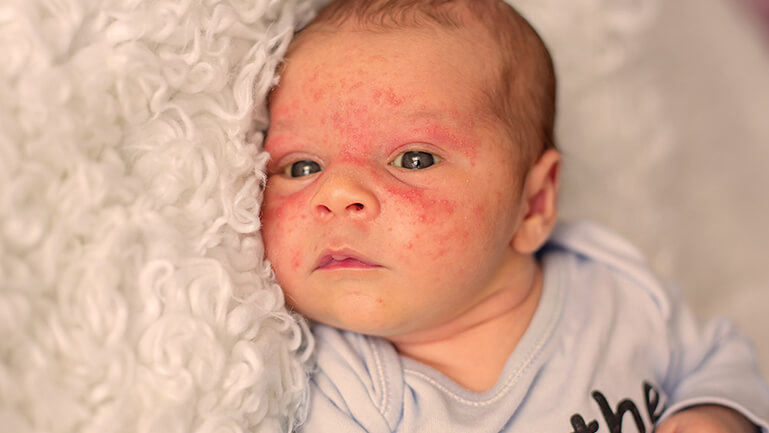Reduziere Neurodermitis
mit Sanubiom SkinCare Protect mit Phage Technology
Neurodermatitis

Itchy, red, flaky skin? These can be signs of the insidious skin disease atopic dermatitis. Atopic dermatitis (also known as “atopic dermatitis“) is one of the most common skin diseases of our time.
People with atopic dermatitis suffer from typical symptoms. These include redness, dryness and, above all, agonizing itching. However, the exact causes are still a headache for doctors today.
We know the skin condition in babies as scaly neurodermatitis scalp.
In adults, however, it is more commonly known as unsightly rashes on the face and hands.
The most important facts in brief:
Have you been plagued by nuerodermitis for a long time, but don’t know the background? Find out everything you need to know about atopic dermatitis-prone skin here. We explain what the causes are. We also show you how you can take action to alleviate atopic dermatitis.
SkinCare Protect soothes the skin in cases of neurodermatitis on the face. It soothes itching and eliminates the bacteria responsible for the tendency to atopic dermatitis. It is important to moisturize the skin. Try not to scratch the itchy areas. It is important to moisturize the skin. Try not to scratch the itchy areas. SkinCare Sensitive moisturizes. It is non-greasy, absorbs quickly and gives the skin a perfect moisturizing boost.

Typically, neurodermatitis on the face is characterized by red, inflamed areas of skin that are very dry and flaky. The cheeks, eyelids, forehead and nose are often particularly affected. The skin can react very sensitively to touch and often feel irritated and uncomfortable.
Itching is a typical symptom that is often very pronounced and can lead to constant scratching. This can further irritate and injure the skin, making the condition even worse. Many sufferers also experience a burning or stinging sensation on the skin.
In some cases, atopic dermatitis can also manifest itself as blisters and pustules on the face, which are often filled with fluid. These can be very painful and entail an increased risk of infection.
An important factor in atopic dermatitis is a lack of omega-3 fatty acids. These essential fatty acids are crucial for skin health and can help reduce inflammation and strengthen the skin barrier. Omega-3 fatty acids are found in oily fish such as salmon, mackerel and herring, but also in linseed, chia seeds and walnuts.
Another important nutrient that is often lacking in atopic dermatitis is vitamin D. This vitamin plays an important role in regulating the immune system and skin health. A lack of vitamin D can lead to a weakened immune system and an impaired skin barrier. Vitamin D can be absorbed through sunlight and certain foods such as fish, liver and egg yolk.
Zinc is also an important nutrient that can be lacking in atopic dermatitis. Zinc is crucial for wound healing and can help to reduce inflammation. Good sources of zinc are meat, fish, nuts and seeds.
In addition to these nutrients, a lack of vitamin B12, iron and vitamin E can also play a role in atopic dermatitis. A balanced diet with plenty of fruit, vegetables, wholegrain products and healthy fats can help to alleviate the symptoms of atopic dermatitis and support skin health. In some cases, however, it may also be advisable to take dietary supplements or special diets in consultation with a doctor or nutritionist.
There are several reasons why atopic dermatitis can only occur on the face.
First of all, the face is a particularly sensitive and exposed region of the body. It is constantly exposed to the environment, including sunlight, wind and pollution. This can lead to skin irritation and inflammation, which increases the risk of atopic dermatitis.
Another reason for the occurrence of neurodermatitis on the face is the high concentration of sebaceous glands in this region. The sebaceous glands produce oil that protects and moisturizes the skin. However, if too much oil is produced, this can lead to clogged pores and skin irritation, which favors the development of atopic dermatitis.
Stress can also be a trigger for neurodermatitis on the face. Stress can weaken the immune system and increase skin sensitivity. In addition, scratching and rubbing the face due to stress can lead to skin irritation and inflammation, which exacerbates atopic dermatitis.
A genetic predisposition can also lead to atopic dermatitis on the face. If other family members suffer from atopic dermatitis on the face, it is more likely that you are also affected.
Overall, there are various factors that can contribute to atopic dermatitis only occurring on the face. A healthy lifestyle, appropriate skin care and managing stress can help to alleviate the symptoms of atopic dermatitis and reduce the risk of future flare-ups. In severe cases of atopic dermatitis, however, it is important to consult a doctor who can make individual treatment recommendations.

To moisturize dry and irritated skin, SkinCare Sensitive is the perfect complement to SkinCare Protect with Phage Technology.
SKINCARE Sensitive contains:
SkinCare Sensitive is dermatologically tested and contains no fragrances.
Without silicones, parabens, kerosenes, PEGs, PAKS, aluminum, microplastics, without cortisone.
People with atopic dermatitis should avoid foods that can trigger allergic reactions or inflammation. These include:
It is important to note that everyone can react differently to food. It is therefore advisable to identify individual trigger foods and avoid them if necessary. A balanced diet with plenty of fruit and vegetables, wholegrain products and healthy fats can help with atopic dermatitis.
Author: Christian Unterlechner, Dipl.-Ing. (FH), MBA
“From our own experience with neurodermatitis – and the long path of suffering associated with skin conditions like this – we started to look for alternative solutions to drug treatments. We are very happy to share the knowledge and experience that has gone into the years of developing our SkinCare products with you.”
Share post